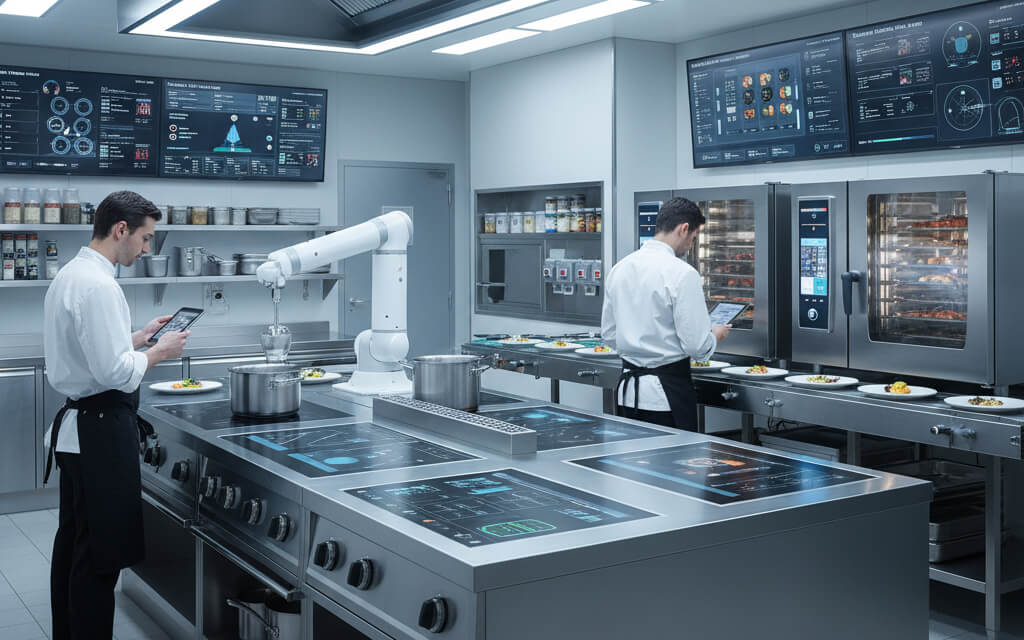October 13, 2025

The restaurant industry is undergoing a rapid evolution, and at the heart of this transformation lies the smart kitchen — a technology-driven ecosystem that’s reshaping how restaurants manage costs, enhance customer service, and streamline operations. By leveraging automation, IoT (Internet of Things) devices, and data analytics, smart kitchens are not just speeding up food preparation — they are redefining the very economics of the restaurant business.
As technology continues to disrupt traditional restaurant models, smart kitchens represent the next frontier in operational efficiency and profitability. Here’s how they are changing the game.
A smart kitchen uses technology to automate and optimize various aspects of restaurant operations. It integrates connected appliances, AI-powered cooking systems, real-time inventory management, and digital order processing. Smart kitchens rely on data and connectivity to ensure food quality, minimize waste, and improve overall efficiency.
In a smart kitchen, every component works in sync:
In short, a smart kitchen is efficiency powered by intelligence, allowing restaurant owners and chefs to focus more on creativity and customer service while letting the technology handle the mundane tasks.
Traditional kitchens often experience operational inefficiencies such as food waste, long prep times, and inconsistent portion sizes — all of which eat into profits. Smart kitchens address these challenges directly by automating routine tasks and integrating data analytics to make smarter decisions.
Key economic benefits include:
Together, these technologies can reduce operational costs by 15–25%, boosting profitability while maintaining the quality and consistency of food.
For a deeper dive into how data-driven decisions are shaping restaurant economics, explore Using Customer Data to Make Smarter Menu Decisions.
One of the biggest advantages of a smart kitchen is its ability to generate valuable data that extends beyond the kitchen itself. By integrating Point-of-Sale (POS) systems, online ordering platforms, and kitchen management tools, restaurant owners can access real-time insights into menu performance, ingredient usage, and customer preferences.
For example:
By using this data to inform menu design, pricing strategies, and inventory management, restaurants can ensure that every item on the menu is aligned with profit goals.
For more on how to leverage digital tools to enhance menu performance, read Online Menus — Why They Matter More Than Printed Ones.
While smart kitchens enhance the overall efficiency of operations, their true value lies in how they improve staff productivity. Rather than replacing chefs or kitchen staff, smart kitchen technology empowers them by eliminating repetitive, time-consuming tasks.
Here’s how smart kitchens improve workflow:
By streamlining the workflow, smart kitchens ensure faster order fulfillment, consistent food quality, and a more cohesive customer experience — all of which translate into better reviews and higher customer satisfaction.
To learn how better coordination leads to stronger customer trust and engagement, explore The Restaurant Reputation Playbook — How to Win Diners’ Trust Online.
In an era where sustainability is increasingly important to consumers, smart kitchens offer a solution that balances profitability with eco-consciousness. These kitchens provide tools that help reduce food waste, energy consumption, and overall environmental impact.
Examples of eco-friendly technologies in smart kitchens include:
By implementing these technologies, restaurants not only lower their environmental footprint but also improve their sustainability credentials, which can be a powerful marketing tool.
Smart kitchens are not confined to the back of the house; they also play a significant role in customer relationship management (CRM). By connecting kitchen data with customer preferences, restaurants can use technology to create personalized experiences both online and offline.
For example:
This data-driven approach to marketing helps restaurants build stronger customer relationships and drive repeat business, fostering loyalty and increasing customer lifetime value.
For more insights into how you can leverage customer data for marketing, read Email Marketing for Restaurants — Grow Customers Beyond Social Media.
As we look to the future, smart kitchens will continue to evolve, pushing the boundaries of data, automation, and adaptability. With new advancements in artificial intelligence, machine learning, and IoT, kitchens will become even more efficient and responsive to both operational needs and customer demands.
In the next decade, restaurants will rely increasingly on data and automation to serve more guests at higher profit margins with smaller, more efficient teams. Cloud-based platforms and smart kitchen networks will allow restaurant owners to manage multiple locations seamlessly from a single dashboard.
Restaurants that adopt smart kitchen technology today won’t just save money — they will future-proof their business for the competitive landscape of tomorrow.
The transformation of the restaurant industry through smart kitchens is already underway, and it’s clear that the benefits are vast. From cost savings and streamlined operations to sustainability and improved customer experiences, smart kitchens are reshaping the economics of dining.
For restaurants looking to stay ahead of the curve, embracing this technology isn’t just an option—it’s essential for long-term success. By implementing smart kitchen systems, restaurants can reduce costs, enhance operational efficiency, and build a more profitable, sustainable, and customer-centric business model.
Stay up to date with the latest tips, expert insights, product reviews, and step-by-step guides to help you grow, create, and succeed—no matter your industry or passion.